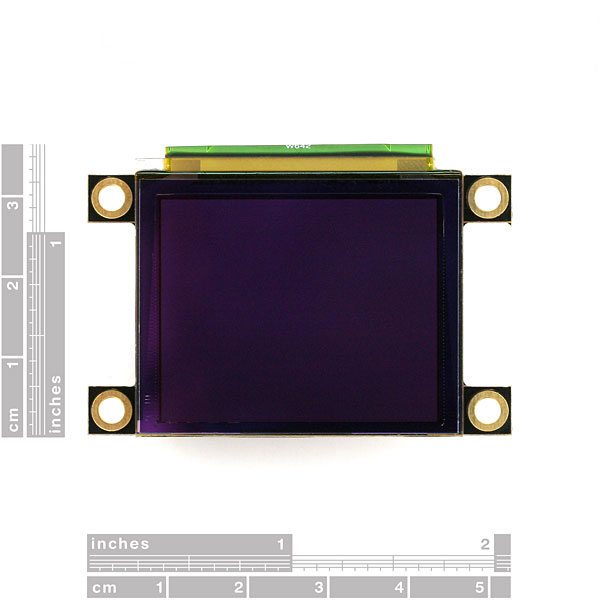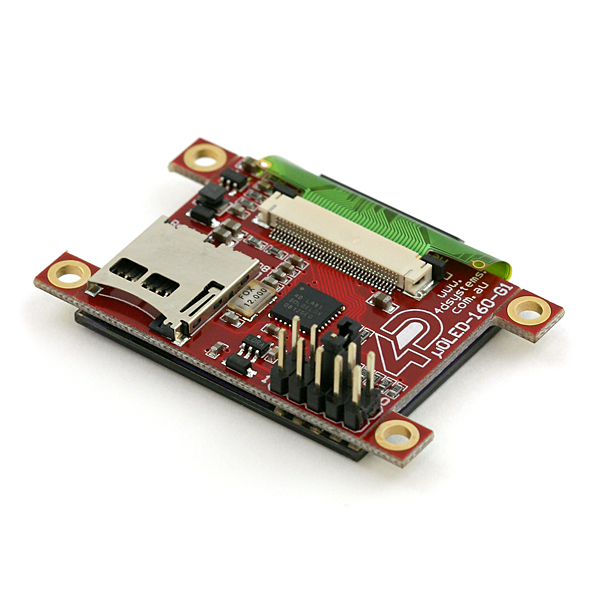×
SparkFun will be closed on Tuesday, November 5th to support our team in being able to go out and vote! Orders placed after 2 pm MT Monday, November 4th will ship on Wednesday, November 6th. Thanks for your patience and understanding.
Serial Miniature OLED Module - 1.7" (uOLED-160-G1GFX)
Replacement: None. We don't carry a direct replacement for this part but check out the rest of our color LCDs. This page is for reference only.
4D Systems' line of smart miniature OLEDs make it easy to add dazzling, full-color graphics and text to your embedded project. By incorporating their powerful GOLDELOX embedded graphics controller, 4D has taken the load off of your system. The uOLED board also has an on-board uSD card slot where you can store images, animations, icons, etc.
Two different firmwares are available from 4D Systems and either of the two can be loaded onto the GOLDELOX chip at any time. The GFX firmware is designed to act as a standalone microcontroller which you can program with the 4DGL language, which is similar to C. The SGC firmware configures the module to act as a slave processor, communicated via serial and handling only the graphics processing tasks while your favorite microcontroller does the external control.
The uOLED-160-G1 is the largest (if you can call it large) of the smart miniature OLEDs from 4D Systems measuring in with a 1.7" screen. Check out the 4D Systems product page for more information about the firmware options (PmmC) and how to swap them out!
Note: It's been brought to our attention that trying to program the 4D screens using an FTDI breakout can damage the driver. You'll need to use the FT232RQ USB to Serial which you can find in the related items below.
- 160 x 128 pixel resolution
- 65K colors
- 1.7” diagonal (active area: 33.6x26.9mm)
- OLED requires no backlight with near 180° viewing angle
- Easy 5 pin interface to any host device: VCC, TX, RX, GND, RESET
- Voltage supply from 3.6V to 6.0V, current @ 40mA nominal when using a 5.0V supply
- Serial (0V to 3.3V) with auto-baud feature (300 to 256Kbps)
- Powered by the GOLDELOX processor
- 2 interfaces: Serial Command platform (factory default) or the 4DGL (4D Graphics Language) platform
- Onboard micro-SD (μSD) card socket for storing of icons, images, animations, etc. (64Mb to 2Gb)
- Three selectable font sizes (5x7, 8x8 and 8x12)
- Built in graphics commands such as: LINE, CIRCLE, RECTANGLE, TEXT, USER BITMAP, BACKGROUND COLOR, PUT PIXEL, IMAGE, etc.
Comments
Looking for answers to technical questions?
We welcome your comments and suggestions below. However, if you are looking for solutions to technical questions please see our Technical Assistance page.
Customer Reviews
No reviews yet.




Please beware: it may support "displaying images and video from a micro-SD card" but by reading the documentation I see that it doesn't support a filesystem or widely-used file formats.
In other words, no FAT32, no JPEG, no GIF, no PNG, no MP4. It's all block addresses and raw data.
If you RTFM "correctly" you will see that you need to download free software available on there website to accomplish this...and yes it works....
The free software is Windows-only. And if an external program on a computer is doing the job of converting existing files to something specific and writing directly to the micro-SD blocks, then I don't count the unit itself as supporting a filesystem and file formats.
For the price of the unit, you'd think it would be able to do all of this on its own.
The site here says the input voltage is 3.6V to 6.0V, but the datasheet says the Range is 4.0V to 5.5V. So which is it?
Is it possible to dismount the LCD from the board and put it at 90 angle to be used in a projection setup?
Interesting idea, but two things:
1: The resolution will make the projector have an extremely low pixel density. If you have a small, color cell phone from the early 2000s, look at it through a magnifying glass, and you'll see what I mean. 2: It's an OLED display, which does active emissive as opposed to filtered transmissive of the LCD. The only way you'll be able to make a projector out of this screen is by putting a magnifying glass in front of it and projecting an up-side down image on a wall. For examples, look up "Box Projector" on Youtube.
When we ordered a few of these uOLED screens a couple months ago, they were the SGC version. We just received two more, of the GFX type, which we only realized after a day of trying to figure out why they weren't taking any serial commands. Apparently they're reflashable (PmmC file and loader from 4D's website) so not a big deal, but be aware if you're having trouble.
very true. we had some issues with them sending either module to us. we're trying to double-check that before sending them out. sorry for that.
I purchased my module from a Sparkfun reseller in the UK, and it came with the GFX firmware. Annoying, but not really a problem as it can be changed with an FTDI breakout quite easily.
This screen offers incredibly bright and vivid colours.
The Serial_LCD library I wrote for the Picaso-powered uLCD32 screen can low handle this Goldelox-based uOLED screen.
See here for more details and download.
Have fun!
After agonizing over the 0.96" screen with nearly the same controller for months and going through all the outdated or dysfunctional libraries available for it, I found one that works with the Uno / 328 and the most recent Arduino IDE. Again, this is all for a slightly different screen, but it is a decent hello world for 4D serial controlled screens.
The library is available at: http://code.google.com/p/arduino-oled/
And I wrote up a basic Oscilloscope sketch for it that includes a trigger feature, it's posted at:
http://nodechomsky.com/post/3749787199/oscilloscope-for-arduino-and-4d-graphics-controller
and video of it in action (it's a bit blurry, but my camera is awful)
http://nodechomsky.com/post/3750164143/this-is-the-output-from-my-arduino-based-diy
They are $60 on the 4D website.
http://shop.4dsystems.com.au/serial-display-modules/208-1003.html
We wrote a little article about these 4Dsystem's OLEDs and how to use them in your own project a while back:
http://metku.net/index.html?path=articles/4dsystems-
oled-technology/index_eng
when are you expecting this to be stocked again ?
Do you expect to have these in stock soon?